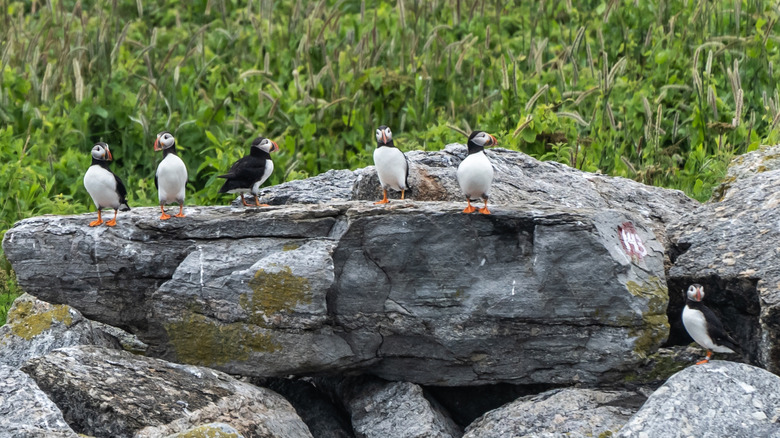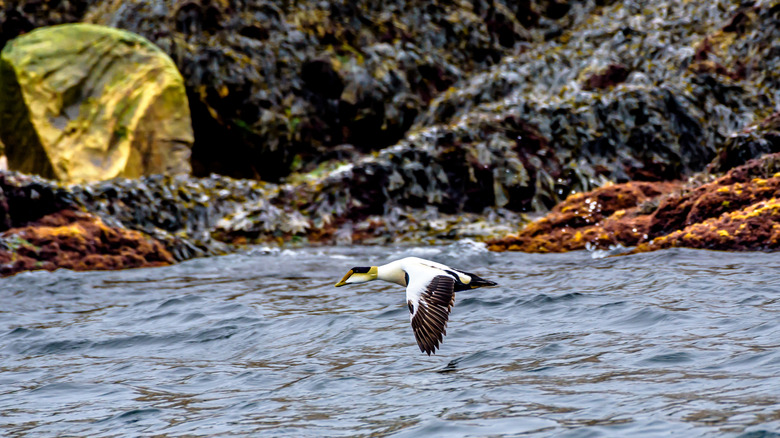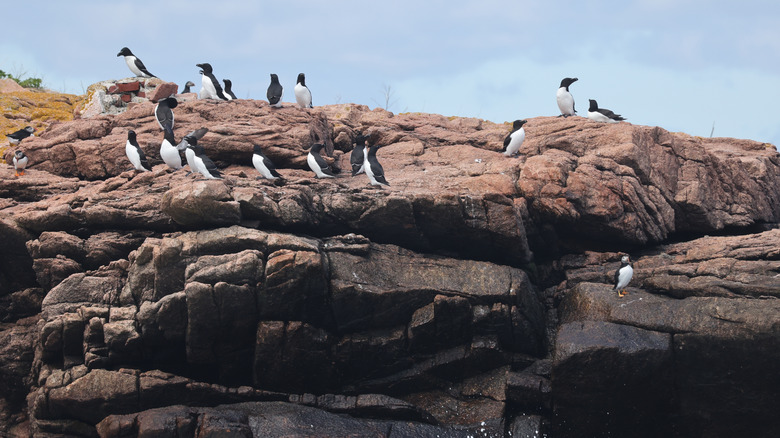One Of America's Only Nesting Sites For Puffins Is On A Scenic Maine Island With Incredible Views
Traveling for wildlife offers a unique way to experience nature, whether it's witnessing bison roam Yellowstone or seeing giant seals up close in California. In Maine, too, the rugged coastline teems with diverse wildlife. Gulf Hagas, a canyon hiking destination full of wildlife, is just one of the state's many outdoor gems. But one of Maine's most enchanting wildlife experiences is found offshore, on a small but lively island: Eastern Egg Rock, home to a colony of puffins.
Located off the coast of St. George, Maine, Eastern Egg Rock is a sanctuary of granite boulders, devoid of trees but rich with life. Managed by the National Audubon Society, it serves as a protected nesting site for puffins, one of only a handful of Maine islands to host these striking seabirds in the U.S. With their black-and-white plumage, bright orange feet, and oversized beaks, puffins are cartoonishly adorable. The island is also a seasonal home to an array of other seabirds, including terns, guillemots, eiders, and even bald eagles. Occasionally, seals can be spotted basking on the rocky shoreline, too. Special boat tours provide an opportunity to see this extraordinary wildlife haven up close.
How to visit Eastern Egg Rock
Visiting Eastern Egg Rock requires a boat tour, and two companies offer excursions led by experts from the National Audubon Society, who have played a crucial role in bringing puffins back to the island. One option is Cap'n Fish's Cruises, which departs from Boothbay Harbor, one of Maine's most underrated coastal towns. Getting to Boothbay Harbor is relatively simple: You can fly into Portland, Maine, and drive an hour and 15 minutes north. Buses from Boston also stop in Wiscasset, a nearby town. The other tour, offered by Hardy Boat Cruises, departs from New Harbor, which lies on a separate Maine peninsula but is accessible via the same travel routes. To get around the area easily, you may want to book a rental car. As of the time of writing, Cap'n Fish's tour costs $59 per adult, while Hardy Boat's costs $51 per adult, with the latter lasting about an hour less.
The journey to Eastern Egg Rock is an experience in itself. The boat glides past several small islands, historic lighthouses, and working lobster boats. Along the way, passengers may spot whales, porpoises, and seals, making it a good idea to keep your binoculars handy. Once the boat arrives near the island, Audubon naturalists provide live narration, pointing out the thriving puffin colony. Eastern Egg Rock itself is rocky, with patches of tall grass, raspberry, and elderberry. Visitors should come prepared with a windbreaker and sunscreen, as the open waters can be both breezy and sunny. While boat tours are available daily, stepping foot on the island is prohibited during breeding season, which runs from April 1 to August 31.
The revival of Eastern Egg Rock's seabird colony
Eastern Egg Rock was not always a bustling seabird sanctuary. Once home to thriving puffin colonies, the island saw its last nesting puffins (before restoration) in 1885 due to egging, hunting, and fishing practices that allowed predator populations to grow unchecked. In response, Project Puffin was started in 1973 to restore Maine's puffin colonies. Naturalists with the project relocated puffin chicks from Newfoundland, Canada, to Eastern Egg Rock, hand-rearing them until they could survive on their own. To encourage returning puffins to nest, researchers placed life-like puffin decoys around the island — a strategy that successfully attracted the real birds over time.
Eastern Egg Rock went on to become the very first restored seabird colony, inspiring similar conservation efforts worldwide. In addition to puffins, researchers used decoys and recorded bird calls to restore the island's tern colony. Today, no people live on the island, aside from a small group of researchers in the fieldwork season who work to protect its ecosystem. For visitors, witnessing this conservation success story — and seeing puffins thriving in the wild — is an unforgettable experience.


